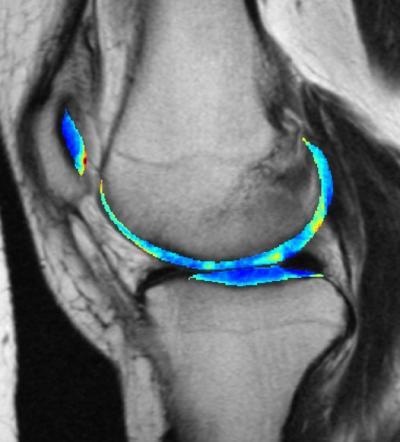Sep 22 2020
Scientists from the University of Pittsburgh School of Medicine and Carnegie Mellon University College of Engineering have developed a machine-learning algorithm that can identify mild signs of osteoarthritis—which are too faint to be perceived by the eye of a qualified radiologist—on an MRI scan performed years before the symptoms started to appear.
 The cartilage in this MRI scan of a knee is colorized to show greater contrast between shades of gray. Image Credit: Kundu et al. (2020) Proceedings of the National Academy of Sciences (PNAS).
The cartilage in this MRI scan of a knee is colorized to show greater contrast between shades of gray. Image Credit: Kundu et al. (2020) Proceedings of the National Academy of Sciences (PNAS).
The study results were recently published in the PNAS journal.
Though this predictive method, patients may someday be treated with preventative medications instead of going through joint replacement surgery.
The gold standard for diagnosing arthritis is by x-ray. As the cartilage deteriorates, the space between the bones decreases. The problem is, when you see arthritis on x-rays, the damage has already been done. It's much easier to prevent cartilage from falling apart than trying to get it to grow again.
Kenneth Urish, MD, PhD, Study Co-Author and Associate Professor of Orthopedic Surgery, University of Pittsburgh
Dr Urish is also an associate medical director of the bone and joint center at UPMC Magee-Womens Hospital.
Currently, joint replacement is the main treatment for osteoarthritis. This condition is so common that knee replacement is the most standard surgery in the United States for individuals aged over 45.
In this study, the team examined knee MRIs from the Osteoarthritis Initiative, which tracked an unlimited number of people for a period of seven years to observe the development of knee osteoarthritis. The researchers targeted a subset of patients who had little proof of cartilage damage at the start of the study.
In retrospect, the team presently knows which of these patients went on to develop arthritis and which did not, and that information can be used by the computer to study mild patterns on the MRI scans of presymptomatic individuals who are predictive of their osteoarthritis risk in the future.
When doctors look at these images of the cartilage, there isn't a pattern that jumps out to the naked eye, but that doesn't mean there's not a pattern there. It just means you can't see it using conventional tools.
Shinjini Kundu, MD, PhD, Study Lead Author, University of Pittsburgh
Dr Kundu finished this project as part of her graduate training in the Pitt Medical Scientist Training Program and Carnegie Mellon Department of Biomedical Engineering.
Currently, Dr Kundu is a resident physician and medical researcher from the Department of Radiology at Johns Hopkins University. To verify this method, she trained the model on a subset of the knee MRI data and subsequently tested it on patients it had never seen before.
78% Accuracy
Dr Kundu performed this dozens of times, with different patients withheld each time, to verify the algorithm on all the information.
On the whole, the algorithm estimated osteoarthritis with am accuracy of 78% from MRIs carried out three years before the onset of symptoms.
At present, no drugs are available to prevent presymptomatic osteoarthritis from growing into a full-blown joint deterioration, although a few highly effective drugs are available that can prevent the development of an associated condition, called rheumatoid arthritis, in patients.
The aim is to develop the same kinds of medications for osteoarthritis. Many candidates are already in the preclinical pipeline.
Instead of recruiting 10,000 people and following them for 10 years, we can just enroll 50 people who we know are going to be getting osteoarthritis in two or five years. Then we can give them the experimental drug and see whether it stops the disease from developing.
Kenneth Urish, MD, Ph D, Study Co-Author and Associate Professor of Orthopedic Surgery, University of Pittsburgh
The study was financially supported by the National Institute of Arthritis and Musculoskeletal and Skin Diseases (grant K08-AR071494).
Other authors of the study include Beth Ashinsky from Drexel University; Mustapha Bouhrara, PhD, and Richard Spencer, MD, PhD, from the National Institute on Aging; Erik Dam, PhD, from the University of Copenhagen; Shadpour Demehri, MD, from Johns Hopkins University; and Mohammad Shifat-E-Rabbi and Gustavo Rohde, PhD, from the University of Virginia.
Journal Reference:
Kundu, S., et al. (2020) Enabling early detection of osteoarthritis from presymptomatic cartilage texture maps via transport-based learning. Proceedings of the National Academy of Sciences. doi.org/10.1073/pnas.1917405117.